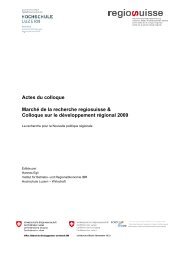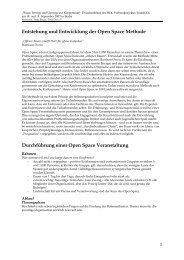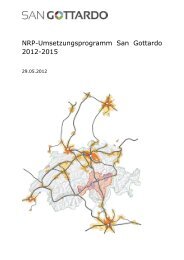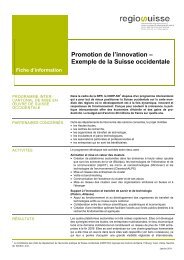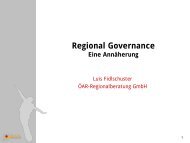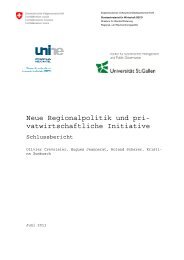Actes du colloque Marché de la recherche regiosuisse & Colloque ...
Actes du colloque Marché de la recherche regiosuisse & Colloque ...
Actes du colloque Marché de la recherche regiosuisse & Colloque ...
Sie wollen auch ein ePaper? Erhöhen Sie die Reichweite Ihrer Titel.
YUMPU macht aus Druck-PDFs automatisch weboptimierte ePaper, die Google liebt.
24 Alberto Bramantimaterial ones, i.e. knowledge, human capital, cultural heritage, and the uniquenessof territories) and on the endowment of the economies of agglomeration (districts andcluster-like networks of firms). Looking at the <strong>la</strong>st two <strong>de</strong>ca<strong>de</strong>s (1990s and 2000s)within different regional <strong>de</strong>velopment p<strong>la</strong>ns we can easily i<strong>de</strong>ntify a complete set ofcomplementary measures, equally wi<strong>de</strong>spread, ranging from ‘supply of real services’to ‘support of technical innovation and technology transfer’; from ‘easier access ofsmall companies to credit’ to ‘<strong>la</strong>bour market policies’; from ‘policies for equipped areas’to ‘environment and tourism’.Notwithstanding different important results achieved, three main mismatches remainstill to be composed and, precisely, they re<strong>la</strong>y to:– finance and budget constraints vs. <strong>de</strong>cision-making level (there is no matchingbetween who collect taxes and who spend public money);– administrative vs. functional regions;– inter-regional coordination and col<strong>la</strong>boration.Italy is now (slowly) implementing in the key areas of health, social assistance an<strong>de</strong><strong>du</strong>cation, the i<strong>de</strong>a to <strong>de</strong>fine the ‘standard costs’ of providing some centrally <strong>de</strong>fined‘essential level’ of services. Even if both the <strong>de</strong>finition of standard costs and the revenuesharing mechanism will surely require difficult negotiations, this is a promisingway to close the gap re<strong>la</strong>ted to the first mismatch.In this frame, Northern regions have implemented different regional policies aiming atfostering their territorial competitiveness, enhancing the quality of the services provi<strong>de</strong>d,and making appropriate use of European structural funds which remain, byand <strong>la</strong>rge, the main source of financing discretional policies.The en<strong>de</strong>mic shortage of regional financial resources, and the further constraint representedby the ‘domestic stability pact’ 5 , have pushed regions to gui<strong>de</strong> their SMEsalong a path of qualitative growth, not only financing them but, most of all, offeringthem know how and competences. Among the most recent regional interventions wefocus on three main fields of actions on which many Northern regions are <strong>de</strong>eply involved:innovation (§ 2); aggregation of firms, mainly SMEs (§ 3); and internationalisation(§ 4).2 Innovation policy: matching ‘proximity’ with technologicalvalue chainNowadays there is a <strong>la</strong>rge agreement at the policy level that innovation (in its broa<strong>de</strong>rmeaning) is a key to the future achieving sustainable long-term economic recovery,as advocated also by the European Strategy ‘Europe 2020’. We strongly need innovation(research and innovation, R&I), particu<strong>la</strong>rly in this international moment, fortwo main reasons:5 The ‘domestic stability pact’ is <strong>de</strong>sign to involve regions and other local authorities in the effort toattain the objectives for general government budget un<strong>de</strong>r control. The stability pact requires localbodies to re<strong>du</strong>ce <strong>de</strong>ficits and their stock of <strong>de</strong>bt.






